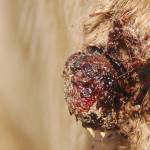New Treatment Tested for Sarcoids in Horses

What better way to fight fire than with fire, especially when it comes to sarcoids? The growths, which normally appear as nodules or flat, hyperkeratotic patches, resist many types of treatment, with many growing larger and more stubborn after treatment attempts. Fire—or more accurately, electricity—was the exact approach a group of researchers took in a recently published study on the topic*.
Delivering electrical impulses directly to the tumor makes cells temporarily “leaky,” thereby allowing injectable chemotherapy drugs, such as cisplatin, to infiltrate and kill tumor cells.
While direct injection of cisplatin into the tumors previously showed promise as a nonsurgical treatment of sarcoids, the high doses required to kill the tumor cells combined with the risk of chemical exposure to the people preparing, administering, and caring for the patient afterward were highly unfavorable. Instead, combining electricity and cisplatin injections requires far lower doses of cisplatin, making the technique much safer for all involved.
According to the study, 18 equids with 52 tumorous nodules underwent electrochemotherapy (ECT). Key findings included:
- A complete response was obtained in over 90% of animals treated with ECT, and a partial response was obtained in the remaining cases;
- Response to treatment was noted after only one to three treatment sessions delivered once every four weeks in most cases. The remaining cases responded within five sessions; and
- Only one case recurred within 60 months of treatment.
Based on those findings, the researchers concluded, “ECT with cisplatin is an effective, safe, and simple local treatment of sarcoids in equids.”
“Electrochemotherapy appears to be beneficial for horses suffering from this common skin condition,” added Kathleen Crandell, Ph.D., a nutritionist for Kentucky Equine Research (KER).
Left unbothered, most sarcoids do not affect the soundness or usefulness of a horse, unless they grown in a place that hinders proper adjustment or fit of tack, or they weep and become attractive to insects. Because of these factors, sarcoids can be a problem for certain horses, so removal is often elected, and ECT looks like a promising solution.
Skin and coat health can be maximized through balanced nutrition, daily grooming, and meticulous attention to even the most minor skin wounds. To bolster coat health, ensure your horse’s diet contains the necessary vitamins and minerals. Hoof and coat supplements such as Bio-Bloom PS (Bio-Bloom HF in Australia) contain full-fat soybean meal and key nutrients for hoof and hair health, including biotin, methionine, zinc, and iodine. In addition, the long-chain omega-3 fatty acids found in fish oil provide a boost in coat quality, as well as precursors to reduce body-wide inflammation.
*Tozon, N, P. Kramaric, V. Kos Kadunc, et al. Electrochemotherapy as a single or adjuvant treatment to surgery of cutaneous sarcoid tumours in horses: a 31-case retrospective study. Veterinary Record. In press.








